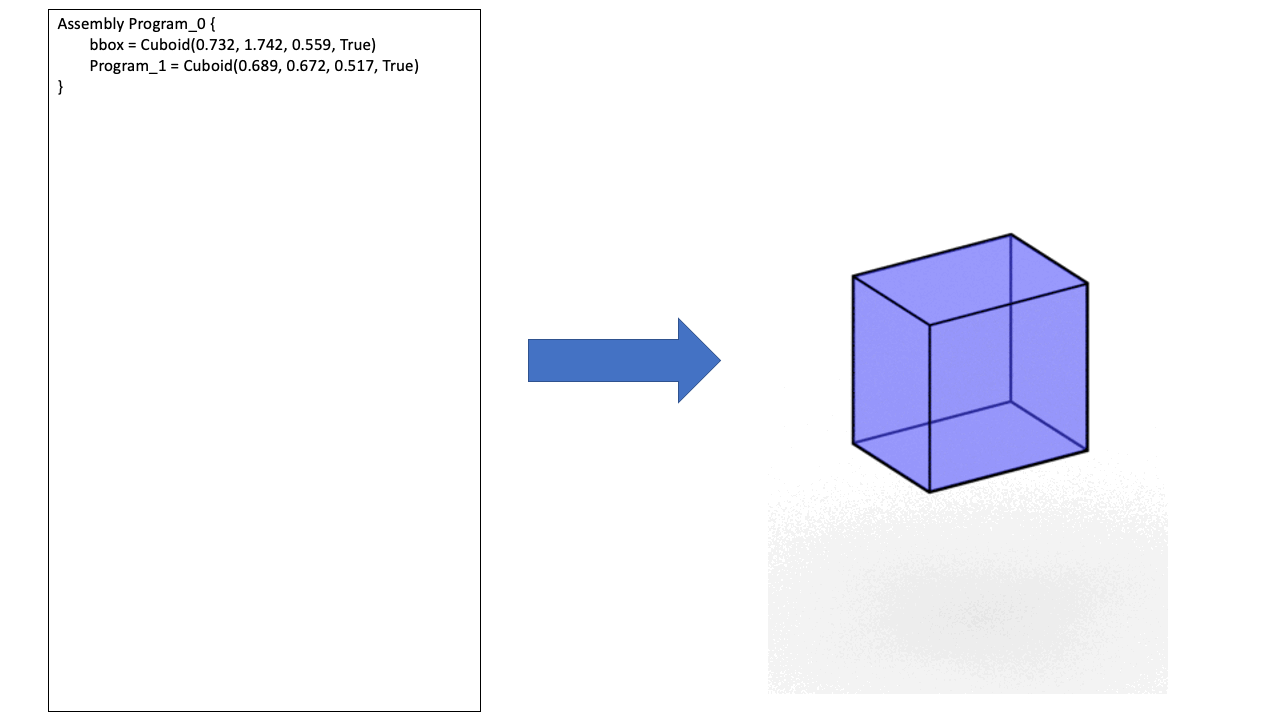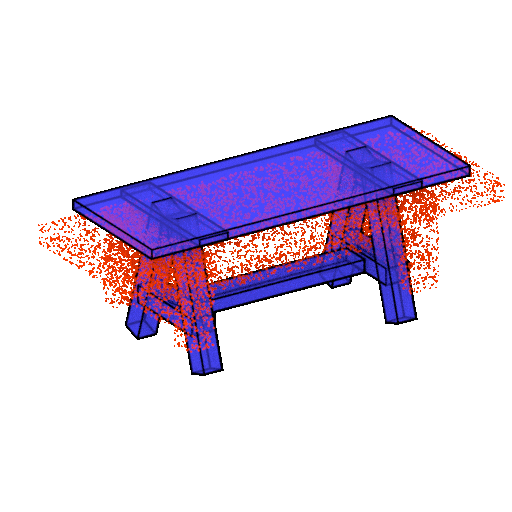By R. Kenny Jones, Theresa Barton, Xianghao Xu, Kai Wang, Ellen Jiang, Paul Guerrero, Niloy J. Mitra, and Daniel Ritchie
We present a deep generative model which learns to write novel programs in ShapeAssembly, a domain-specific language for modeling 3D shape structures. Executing a ShapeAssembly program produces a shape composed of a hierarchical connected assembly of part proxies cuboids. Our method develops a well-formed latent space that supports interpolations between programs. Above, we show one such interpolation, and also visualize the geometry these programs produce when executed. In the last column, we manually edit the continuous parameters of a generated program, in order to produce a variant geometric structure with new topology.
Paper: https://rkjones4.github.io/pdf/shapeAssembly.pdf
Video: https://www.youtube.com/watch?v=YqFaJXWT86o
Presented at Siggraph Asia 2020.
Project Page: https://rkjones4.github.io/shapeAssembly.html
@article{jones2020shapeAssembly,
title={ShapeAssembly: Learning to Generate Programs for 3D Shape Structure Synthesis},
author={Jones, R. Kenny and Barton, Theresa and Xu, Xianghao and Wang, Kai and Jiang, Ellen and Guerrero, Paul and Mitra, Niloy and Ritchie, Daniel},
journal={ACM Transactions on Graphics (TOG), Siggraph Asia 2020},
volume={39},
number={6},
pages={Article 234},
year={2020},
publisher={ACM}
}
The ShapeAssembly DSL is defined in code/ShapeAssembly.py . Within this file, the ShapeAssembly class is the entrypoint for interacting with the language.
Execution
For instance, the file code/data/chair/173.txt describes a chair from our training set. To execute this program, and write the resulting shape to executed.obj, from the command line we can run:
python3 ShapeAssembly.py run data/chair/173.txt executed.obj
from the code directory. Or from a python shell we can run:
> from ShapeAssembly import ShapeAssembly
> sa = ShapeAssembly()
> lines = sa.load_lines('data/chair/173.txt')
> sa.run(lines, 'executed.obj')
The interace for executing a non-hierarchical program is very similiar (just replace run with run_local). The file code/data/examples/ex-0.txt contains a non-hierarchical ShapeAssembly program describing a table-top.
Program Fitting
In order to opitimize the parameters of a ShapeAssembly program using our differentiable executor, the diff_run function must be used. We provide a toy example demonstrating differentiable execution in code/example_fit.py. The command:
python3 example_fit.py data/table/33075.txt data/examples/comp_pc.obj fit
was used to optimize the parameters of the below shape-program to minimize chamfer distance against a target point cloud.
The model for generating ShapeAssembly programs is defined in code/model_prog.py
Training
The command to train our model on the chair category can be run from the code directory as:
python3 model_prog.py --dataset_path data/chair/ --category chair --exp_name chair_exp
Training results from this run will be placed in model_output/chair_exp.
Shape Generation
We also include pre-trained models for the chair, table and storage categories. These can be found in the code/model_output/pre_* folders.
To generate shapes from these pre-trained models the following command structure can be used:
python3 model_prog.py --mode eval_gen --num_gen 10 --exp_name pre_chair --model_name pre_chair --load_epoch 119
This will generate 10 chair-programs and output them in code/model_output/gen_pre_chair.
Point Cloud -> Program
To use our pre-trained point cloud -> shapeAssembly models for chairs, please see the README's in the pc_data and pointnet2 directories. Once those are set-up correctly, you can infer a shapeAssembly program from a point cloud sampled from a PartNet chair with such a command:
python3 chair_program_from_pc.py test_pc 2307
This will infer a ShapeAssembly program from the point cloud of shape 2307 and write the output to the directory test_pc.
In order to train a new point cloud -> ShapeAssembly model, please see the helper functions in the pc_data directory, and follow the training procedure described in the paper.
**Other Relevant modeling files **
parse_prog.py -> functions for tensorizing/un-tensorizing text-based ShapeAssembly programs
losses.py -> define losses used during training
sem_valid.py -> logic implementing semantic validity checks used when decoding ShapeAssembly programs at eval time
metrics.py -> functions for computing metrics of the generative model's performance. pointnet_classification.py, valid.py and voxelize.py are metric helper files.
We provide our parsed ShapeAssembly datasets for chairs, tables and storage categories in the code/data folder.
To re-generate these datasets, or to run our program parsing procedure on other part-graphs, please use the gen_data.py script in the code directory.
If part-graph json files are placed in /home/{USER}/pnhier/{category} for a given category, ShapeAssembly programs can be generated with a command like:
python3 gen_data.py {category}
Additional program checks can be enforced by running code/clean_data.py on the resulting parses.
Other relevant program parsing files:
json_parse.py -> parse a hierarchical part-graph into collection of attributes needed for its corresponding ShapeAssembly program. Point cloud intersection logic takes place in intersect.py. Symmetry detection logic takes place in symmetry.py.
generate.py -> takes a collection of attributes and formulate a ShapeAssembly program. Attachment statement ordering logic is within attach_order.py. Detection of squeeze attach operators takes place in squeeze.py.
Code was tested on Ubuntu 18.04 with pytorch 3.7. env.yml should contain a further list of all the conda packages/versions used to run the code.


